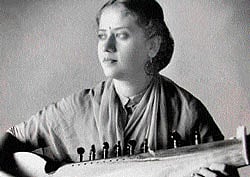I was with the Limca Book of Records when Sharan Rani was honoured by the Sahitya Kala Parishad at a glittering function with maestros, artistes and music lovers from all over the country.
Her book, The Divine Sarod, written after years of study and research, was also released then. She already featured in our book as the first woman to play the sarod professionally, a fact that had intrigued me all along.
There were so many famous women sitarists, including Annapurna Devi, from the same Senia Maihar Gharana. Why not more women players of the sarod as well? I was keen to find out and to know more about her musical journey. She called me over to hear all about it. It was one of the most memorable evenings of my life.
“How did it all begin?” I had asked her.
“I have loved the sound of music ever since I can remember,” she replied with a smile.
Sharan had learned classical music from a very young age and also learned Kathak and Manipuri when she was just seven. Whenever there were weddings in the family and music was played, Sharan danced to the music spontaneously.
Moreover, she had a special interest in musical instruments and tried to pick up the sargam on her own. She had a brother who collected musical instruments as a hobby.
He once came across a crudely made sarod and bought it immediately. Sharan tried her hand at it as soon as she saw it, playing it with the help of a copper coin. She even played it at a public function where Ali Akbar Khan happened to be present. Intrigued and impressed by the performance of the 10-year-old Sharan, he offered to teach her himself.
After that there was no looking back. She eagerly continued her training under Ali Akbar Khan. But he was a famous and busy man and could not give her lessons regularly, although Sharan kept up her riyaz faithfully. After a while, he himself suggested she learn directly from his father, Baba Allauddin Khan, who lived in Maihar. Sharan was in college when she decided to visit him there. But the great maestro was upset when she told him that she wanted to learn the sarod.
“Choose some other instrument, Beti! Sitar, surbahar... anything you like. The sarod is not an instrument for women,” he had told her. Young Sharan had looked him straight in the eye and replied, “It is like saying ‘Love one man but marry another’. I can’t do it, Baba!
I love the sarod, not any other instrument. So I can’t be faithful to another!” Baba read the steady determination in her eyes and gave in. He realised how deeply she loved her chosen instrument and he taught her with all his affection and care. Sharan became the first woman sarod player, soon hailed as exceptional and outstanding by the world of music.
“There has always been this steady love affair between the sarod and myself,” Sharan told me with a twinkle in her eyes, “I have never believed in a marriage of convenience, you see.”
Had it been a particularly tough choice? I had asked her.
“One needs a lot of devotion, determination and the willingness to make any sacrifice if one takes up music seriously,” she replied, “It is especially true of instrumental music where one has to compete mostly with men. And of course, one must have the courage to hold on to one’s convictions, even if it means going against the whole world.”
I was curious to know why Baba Allaudin had forbidden her to learn the instrument in the first place and why so few women chose to learn it. Was it more difficult to play than other string instruments?
“It is difficult to play, no doubt, but that is not the reason,” said Sharan, “The sarod has 21 strings which itself may not be very easy to handle, but the correct posture for playing it demands that you press the instrument against your stomach.
It can’t be placed any other way. I realised how painful it could be when I was pregnant. It was then that I realised why Baba had said that it was not an instrument for women. One just cannot change the posture. Moreover, one has to play with one’s nails. If the sarod slips even by a hairbreadth, it sounds out of tune, unlike the sitar or the veena which can be kept at a distance.”
It was sheer determination combined with will power that had made Sharan Rani a top ranking instrumentalist. Plus the resolve not to admit defeat or be outdone by men! Her music was a remarkable blend of technical brilliance and emotional appeal. Vibrant and expressive, it was also marked by profound depth.
The recipient of numerous honours, awards and titles, she also has a number of “firsts” to her credit. She was the first woman to take up sarod professionally, the first woman instrumentalist to receive the Padma Shree, the first to record her music abroad and so on.
She had also done something quite remarkable. She collected a large number of musical instruments from gullies, mohallas, durbars and the homes of musicians, faqirs and commoners. She picked them up from all over the country, whenever she visited a new place.
Each of these instruments had an interesting history of its own which she noted in her book. She donated most of these instruments to the National Museum in Delhi. The Sharan Rani Buckliwal Gallery of Musical Instruments was inaugurated by Indira Gandhi in 1980.
Sharan Rani’s life was wholly given to music — performing and giving lecture-demonstrations at home and abroad, teaching her pupils, composing new ragas (such as Radhika-priya and Hara Gauri) and continuing her research on music, musical instruments and musicians as long as she lived. She passed away on April 8, 2008, a day before her 80th birthday.

